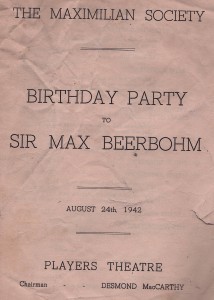 Found—a programme for the seventieth birthday party of Sir Max Beerbohm (1872 – 1956), the well known caricaturist, parodist and all-round wit.
Found—a programme for the seventieth birthday party of Sir Max Beerbohm (1872 – 1956), the well known caricaturist, parodist and all-round wit.
It was held on August 24th 1942 and organised by the Players Theatre, which during the war had moved to a ‘basement ‘ in Albemarle Street. The seventy-strong Maximilian Society, had been created especially for the event, and it was decided that a new member would be added each subsequent year that ‘ the incomparable Max ‘celebrated his birthday. The chairman was ‘Sir’ Desmond MacCarthy, the Bloomsburyite literary critic.
All we can gather from the programme is that much of the entertainment comprised seven Music Hall singing acts who trilled such raffish ditties as‘ Milly’s Cigar Divan ‘, ‘ Sweethearts and Wives’, and ‘ Driving in the Park’ . Beerbohm, who began his career in the 1890’s at the height of the Music Hall era, would have known these songs, and might even have chosen them.
Some of the performers were big names themselves. The actor Frith Banbury ( 1912 – 2008) would star in the classic film ‘The Life and Times of Colonel Blimp’ the following year. Hedli Anderson (1907 – 90), the singer and actress, was associated with the Group Theatre and had previously starred in plays by Auden, Isherwood and MacNeice, whom she married that same year. In fact, ‘Funeral Blues ‘was specially written for her by Auden and put to music by Britten for the Group Theatre’s production of ‘The Ascent of F6’. As we all know, the poem later became the star turn in ‘Four Weddings and a Funeral’.
It is not known whether all the seventy all-male Maximilians, who included some of the best known names in the literary, artistic and theatrical world, were present at the party. Betjeman was on the list but would not have been there, as he was then Press Attache at the British Embassy in Dublin. Some, including Edwin Lutyens and Logan Pearsall Smith, would have been pretty aged by 1942. Others, like, Kenneth Clark, Maurice Bowra Thomas Driberg, Osbert Lancaster, Graham Greene ( who was based in Sierra Leone at the time ) and John Gielgud represented a younger generation of admirers. One of the more intriguing Maximilians was C(harles) R(eginald) D(awes), who has been described by his bibliographer as ‘ England’s last great collector of erotica.’
Unless it is a purely a matter of dividing 70 by 10, we at Jot HQ confess that we do not know why the number ‘7’ seems to be significant in the Maximilian Society, or why the chosen ‘ seven men ‘were Lord Berners, James Bone, Ivor Brown, Philip Guedalla, Moray McLaren and Raymond Mortimer, but we would appreciate explanations from any out there in the Jotosphere.
Nor is it known whether any young female dancers were present to accompany the chorus “ Oh ! The Fairies “
Oh ! the fairies! whoa the fairies !
Nothing but splendour and feminine gender:
Oh ! the fairies ! whoa the fairies !
Oh for a wing of a fairy queen.
[R.M.H.]

Sir Desmond MacCarthy’s knighthood was every bit as real as Max’s, though he didn’t receive it until 1951 and was plain Mr. MacCarthy in 1942. It’s a little surprising that Max was offered and accepted a knighthood, given he had written a “Ballade Tragique a Double Refrain”, The refrains being “The king is duller than the queen” and “The queen is duller than the king” about George V and Queen Mary.
The seven probably comes from Max’s short stories ‘Seven Men’ later issued with ‘ two others.’
Many thanks Roger. One has to assume the royals were unaware of Max’s scabrous verse. Someone must have put a good word for him, possibly Edward Marsh.
Des McCarthy was arguably one of the least deserving recipients of a knighthood in the history of English letters. When he wasn’t faffing around as a critic he was freeloading off various members of the Bloomsbury Group, notably the Woolfs. Read Mrs Woolf’s Diary for her opinion of him. Just about the only useful thing he did was to act as a well paid Secretary to Roger Fry, when he was setting up the famous Post-Impressionist show in 1910, when his main duty was to collect money from visitors to the exhibition.